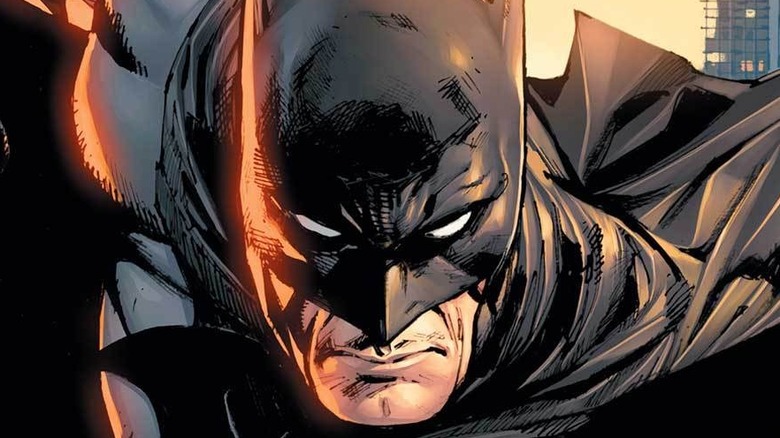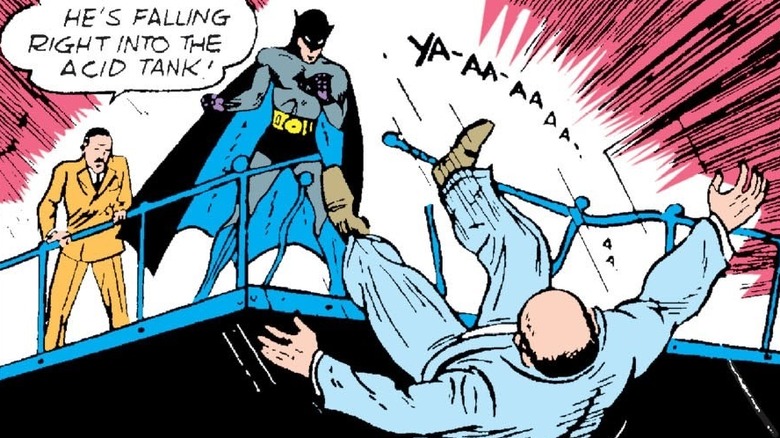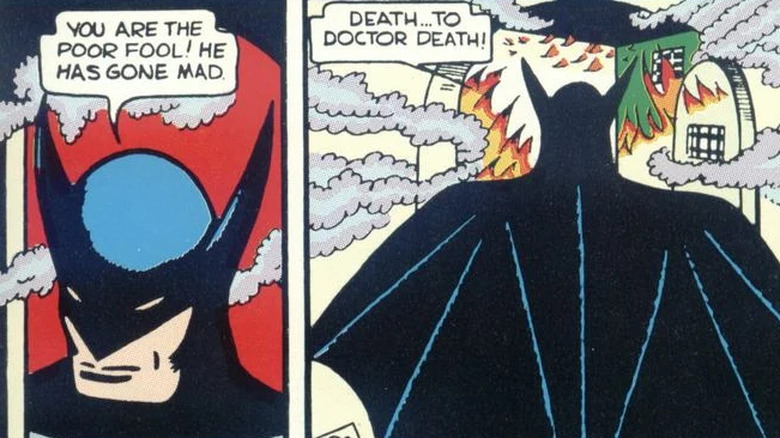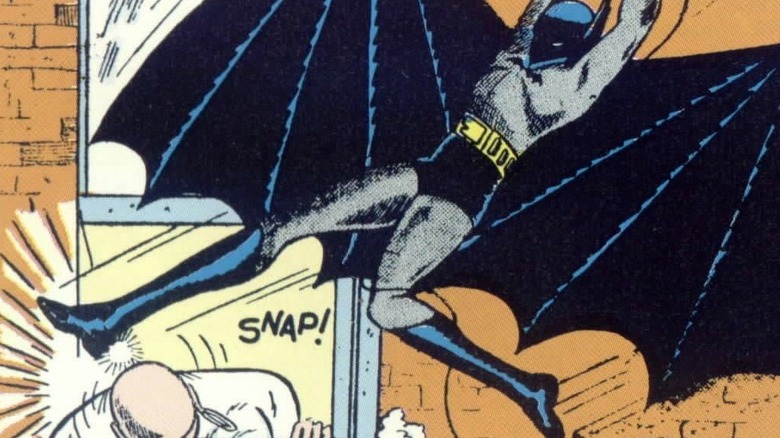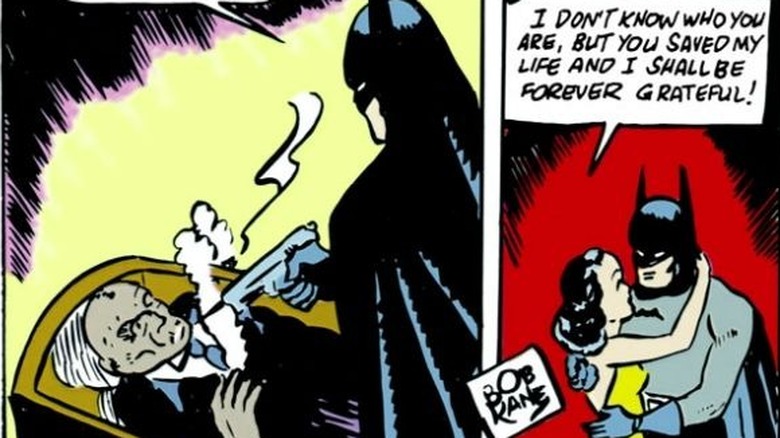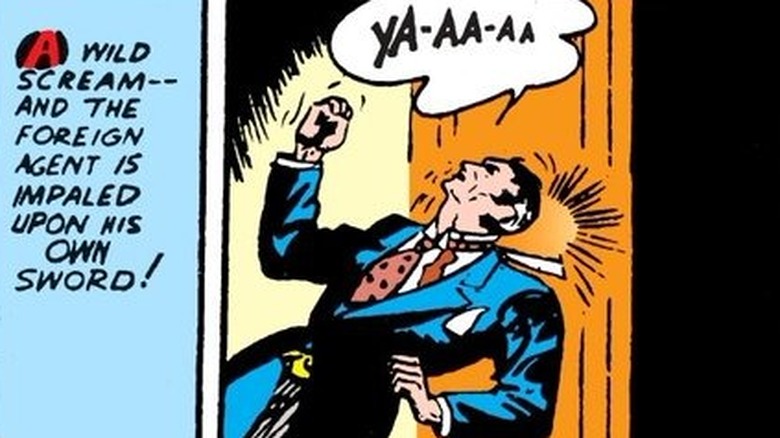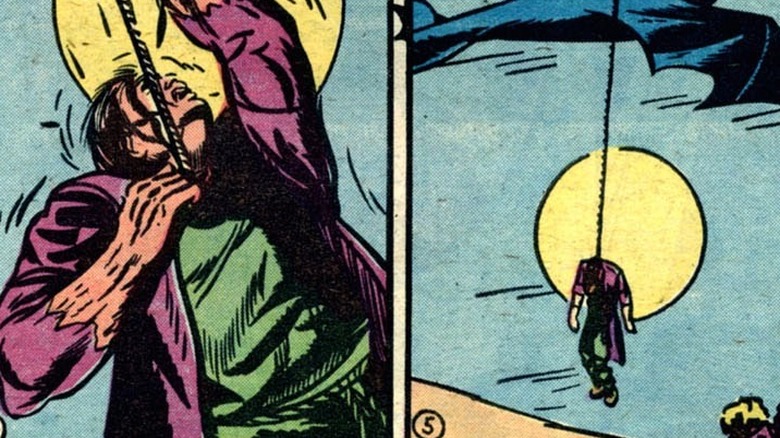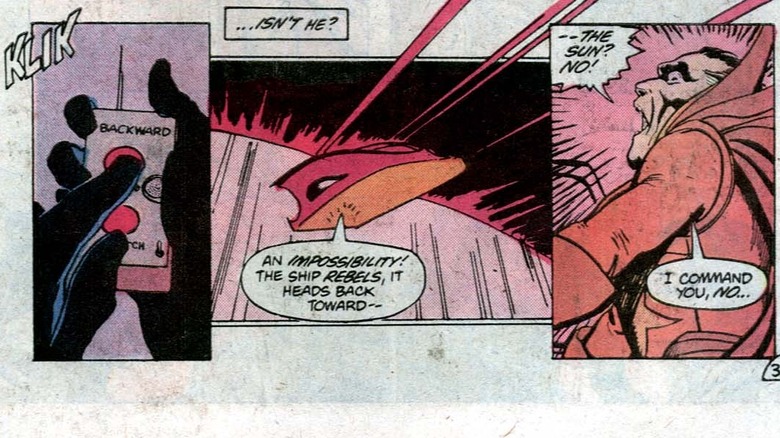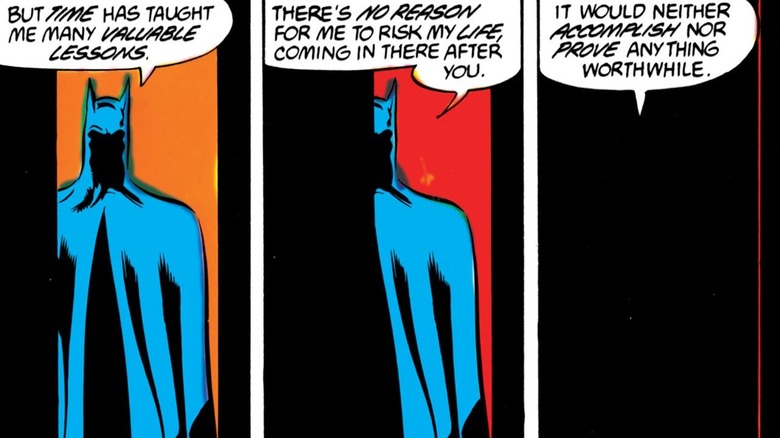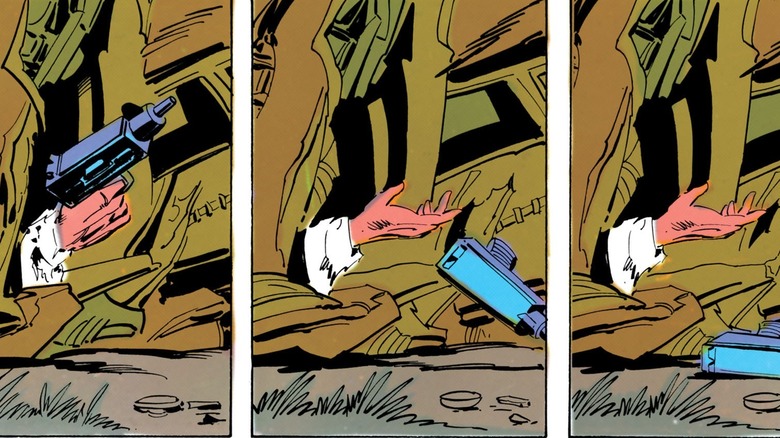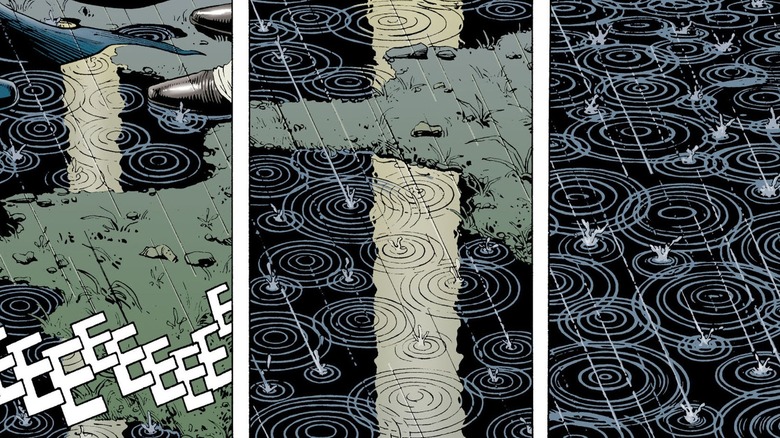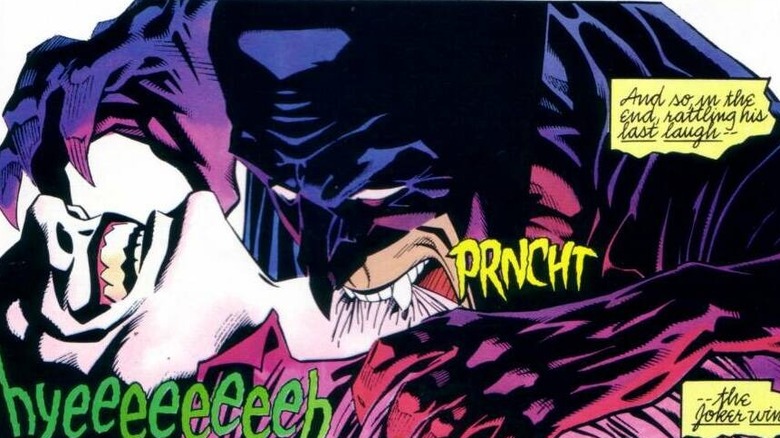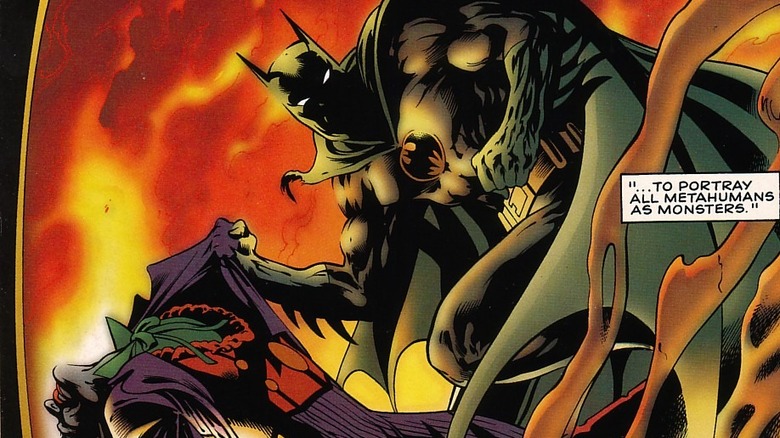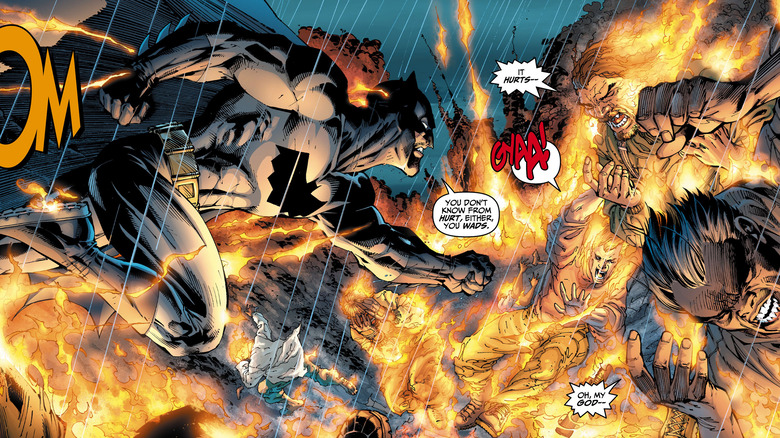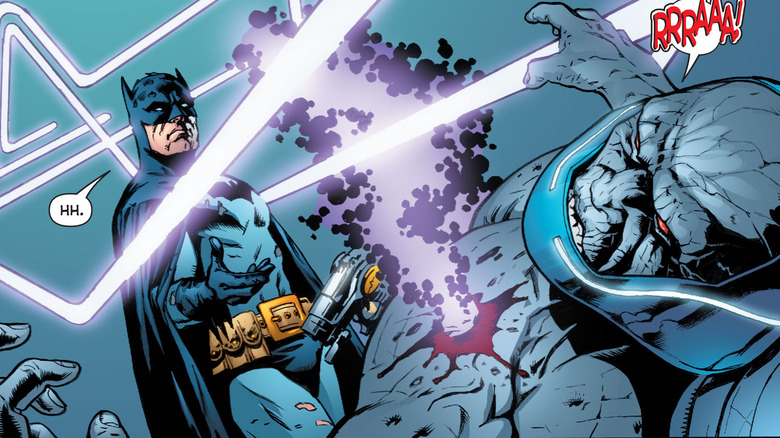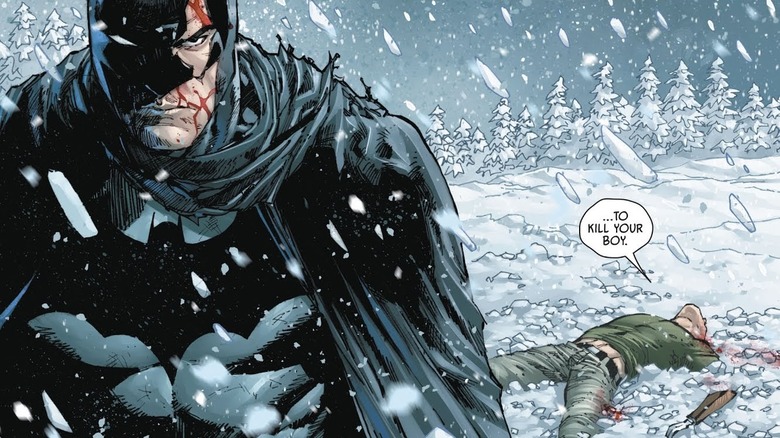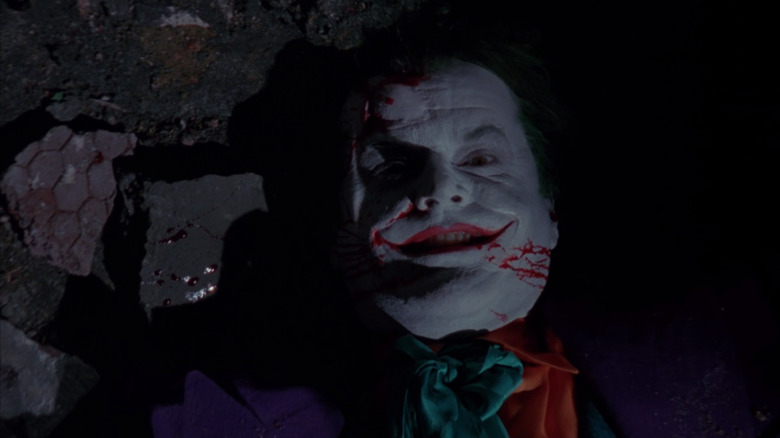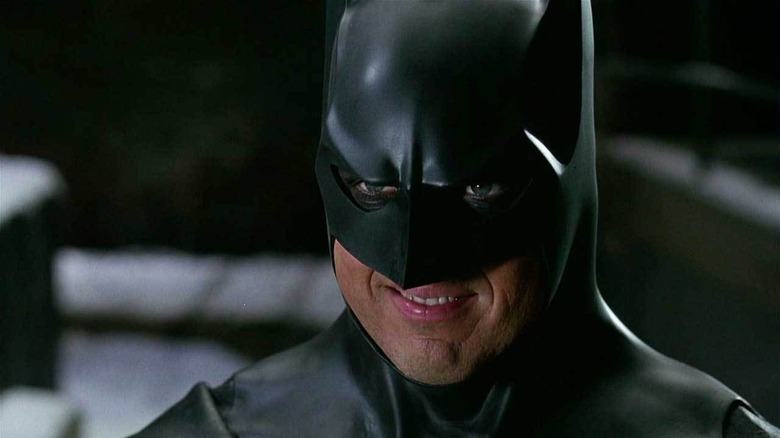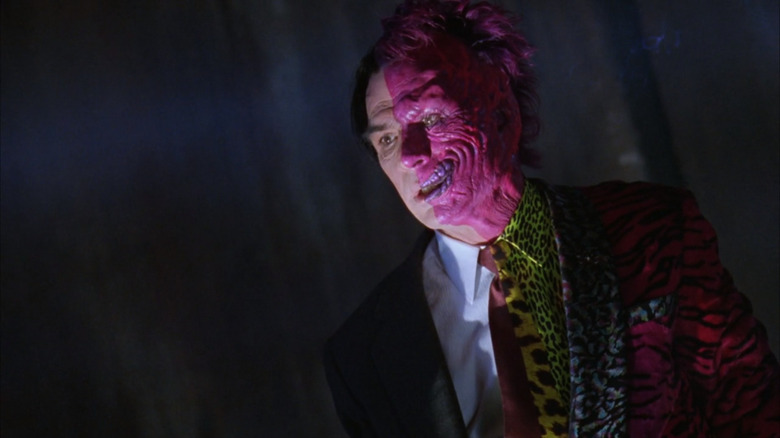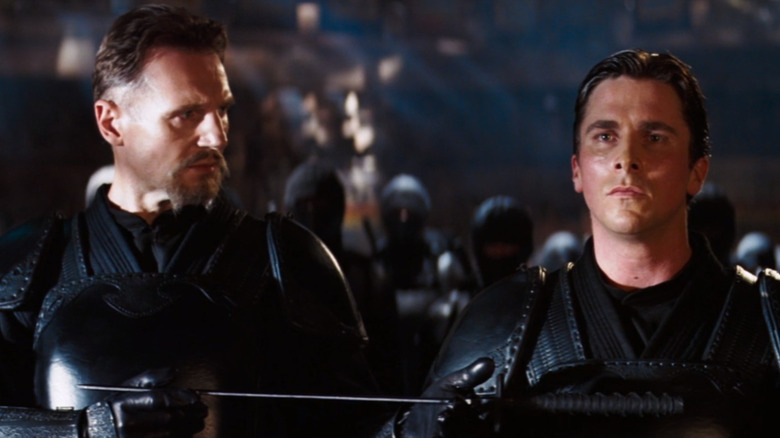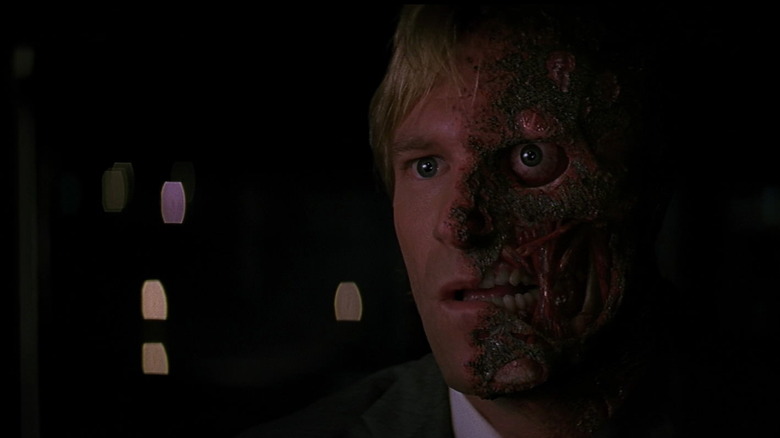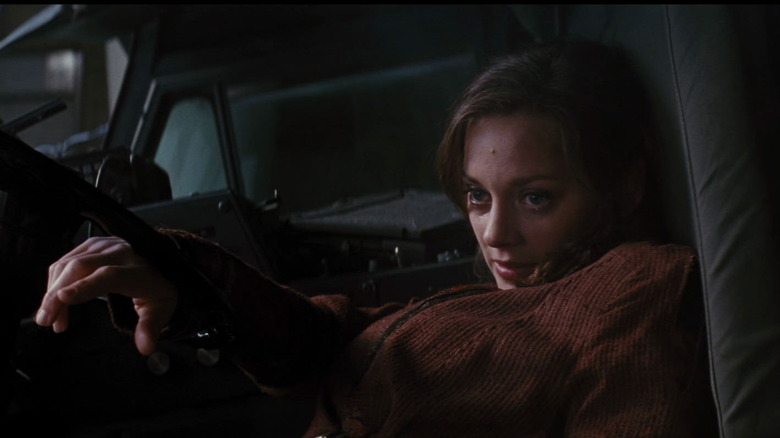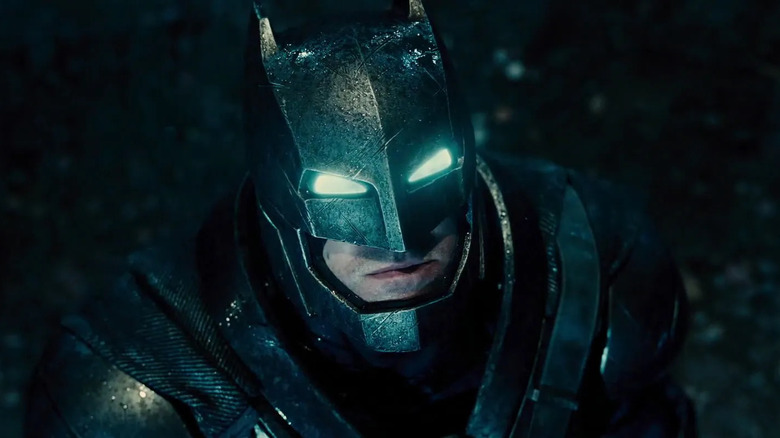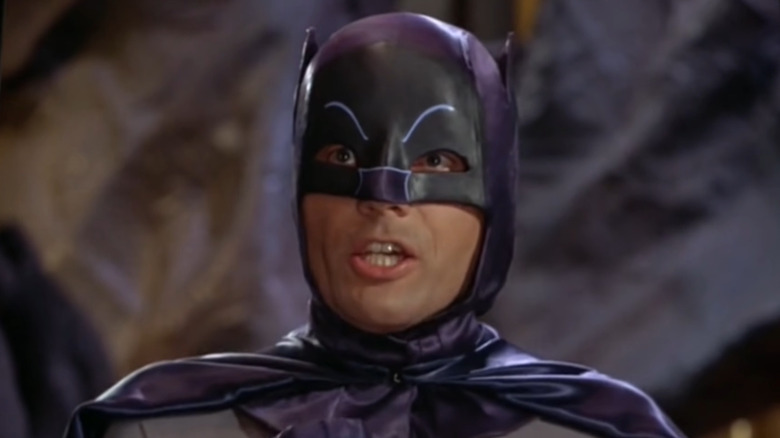Every Time Batman Broke His Biggest Rule
Towards the end of Christopher Nolan's superhero epic "The Dark Knight," the Joker tells Batman that "the only sensible way to live in this world is without rules — and tonight you're gonna break your one rule."
That rule is a simple one: no killing. Batman's refusal to take the lives of his enemies has been one of the character's defining traits for decades, having first been alluded to in 1940's "Batman" #4. In this story, caught up in a sword fight with a gang of pirates, Batman tells Robin to "use only the flat of your sword," as "we never kill with weapons of any kind."
Fast forward 80 years, and Robert Pattinson, star of 2022's "The Batman," is telling Premiere (via The Direct), "There is this rule with Batman: he must not kill. It can be interpreted in two ways. Either he only wants to inflict the appropriate punishment, or he wants to kill and his self-control prevents him from doing so."
While it's clear that the no-kill rule has played a key role in Batman stories through the years, the truth is that his self-control has faltered every now and again. In fact, Batman has taken many, many lives, in both the comic books and the movies, often using incredibly gruesome methods. From shootings to acid vats to hangings and everything in between, here's every time Batman broke his biggest rule.
Detective Comics #27
It's probably fair to say that the Batman of the so-called Golden Age of comics was a little different to the hero you know today. Most notably, this version of the character — who would later be explained away as existing on Earth-Two of the DC multiverse — starts off quite unafraid to kill anybody who gets in his way. As a result, many of the deaths caused by Batman take place within a couple of years of his comic book debut.
In fact, Batman makes his first known kill during his first ever story. In "Detective Comics” #27, the Caped Crusader attempts to solve the murder of a chemical industrialist named Lambert. As it turns out, Lambert, as well as two of his colleagues, were killed by Alfred Stryker, who is attempting to gain control of the Apex Chemical Corporation. Cornered by Batman at Stryker's lab, the villain lashes out and attacks his vigilante foe, but Batman is too quick for him — and knocks him into a vat of acid. Batman, in a remarkable display of apathy, simply declares this "a fitting end for his kind" and flees the scene before the police arrive.
Detective Comics #29
Batman's next kill takes place just two issues later, in "Detective Comics" #29, suggesting that this is less of a crime-fighting career as it is an outright rampage. This time around, Batman's enemy is Doctor Death, a twisted scientist who seeks to use a deadly pollen extract to extort cash out of the world's wealthiest figures. Before he puts his plan into action, however, Death decides to take out the Batman, luring him into a trap set by his henchmen.
Inevitably, the trap fails, and Batman ends up discovering the location of Doctor Death's lair. As he enters, he swiftly dispatches Death's underling, Jabah, with "a snap of a lasso." Death subsequently flees into his laboratory and picks up some kind of "deadly tube", hoping to use it to aid in his escape. Alas, he fails again: Batman hurls a fire extinguisher at him, causing him to drop the tube and spark a massive fire. As the inferno consumes his enemy, Batman — who clearly hasn't nailed down his one-liners just yet — simply states, "Death ... to Doctor Death!"
And while Doctor Death would return a number of times over the years to harass Batman and his allies, the same cannot be said for Jabah, who, let's be honest, definitely perished in that house fire.
Detective Comics #30
Golden Age Batman's killing spree continues in "Detective Comics" #30, the same story that also sees the timely return of one Doctor Death. Bruce Wayne discovers that Death is still at large after a man turns up dead under mysterious circumstances. After he confirms that his latest enemy is to blame for the murder, Bruce suits up and heads off to take down Death for good.
This time, though, it's not Death who finds himself the victim of Batman's cavalier approach to vigilantism — in fact, at the end of the story, he is simply tied up and left for the police. No, the poor soul in question here is a Cossack henchman of Death's named Mikhail, who is implied to be Jabah's successor. Death sends Mikhail to steal a cache of diamonds from the man he has recently killed, but Batman catches him in the act and trails him back to his apartment. This time, Mikhail gets the jump on him; a brief fight ensues, and Batman leaps out of the window. As Mikhail goes to shoot him, Batman ambushes the goon, swinging down from above and kicking him in the head so hard his neck snaps. "First Jabah, now you," Batman says, his lust for blood apparently left unsatisfied. "And yet Doctor Death lives on!"
Detective Comics #32
Over the course of "Detective Comics" #31 and 32, Batman battles the Monk, a vampire with a knack for hypnosis and a homicidal hatred of Batman. For reasons that aren't really explained — other than to provide an excuse for a very loose adaptation of "Dracula," that is — this otherworldly villain hypnotizes Bruce Wayne's fiancée, Julie Madison, and attempts to force her to kill a random man on the street.
Batman soon tracks the vampire to his home in Hungary ("the land of history and werewolves," according to Bruce Wayne's doctor) and quite literally goes in for the kill. After being captured by the Monk and forced into a pit of wolves, Batman makes his escape, climbing to safety and setting out to "seek his vengeance." He crafts two silver bullets, one for the Monk and one for the Monk's right-hand woman, Dala, and loads them into a pistol that he apparently just carries around with him. In the basement of the Monk's castle, Batman finds the two vampires sleeping; claiming that "never again will you harm any mortal being," he approaches their open coffins and shoots them at point-blank range. Bat: 1. Vampires: 0.
Detective Comics #37
In "Detective Comics" #37, the World's Greatest Detective becomes lost on a day-trip in the Batmobile and stops at a house to ask for directions. Inside, he finds a man named Joey being tortured by thugs — but when Batman comes to the rescue, Joey betrays him, knocks him unconscious, and kills his three captors.
Later, Batman follows Joey to the hideout of a villain named Turg. In the ensuing confrontation, Batman explicitly (and possibly deliberately) refers to his previous meeting with Joey, spurring Turg to brand Joey a traitor and stab him to death. That seems cruel enough, of course, but it pales in comparison to what comes next: Learning that Turg and his cronies are foreign spies, Batman intercepts the gang as they attempt to blow up an ocean liner, hoping to kick off an international incident. He picks off most of the bad guys non-violently, but follows their leader back to his stately home — and, after a brief fistfight, impales him on his own sword. "It is better he should die," Batman tells himself. "He might have sent thousands of others to their death on a battlefield."
Harsh? Sure. But considering "Detective Comics" #37's publication date was March 1940, you can probably see the reasoning behind this one.
Batman #1
In the Spring of 1940, Batman found a new home in "Batman," alongside the ongoing run of "Detective Comics." And, as if to reassure readers that the Dark Knight's violent streak had not diminished, "Batman" #1 features at least one clear-cut kill — though you could argue he's responsible for many more.
They all take place in "The Giants of Hugo Strange," the third story in the issue. In this tale, the villainous Professor Hugo Strange — a holdover baddie from "Detective Comics" — develops a formula that can grow human beings into 10-foot giants. He uses this new power on five patients at Arkham Asylum, whom Strange subsequently unleashes on Gotham City. After being captured by Strange's "giants," Batman makes a lucky escape and defenestrates Strange into the ocean beneath his hideout. This, of course, leaves him with a handful of mentally unstable giants to deal with. He tricks two into turning on each other, killing themselves in the process, and takes out another by looping a steel rope around his neck and hanging him from the Batplane. ("He's probably better off this way," Batman claims.)
The final giant attempts to reach the Batplane by scaling a nearby skyscraper. Batman tries shooting him dead to begin with, and when that fails, he resorts to gas pellets instead, forcing the giant to lose his footing and fall to his doom. Heck of a start for "Batman" #1.
Batman Annual #8
Impressively, Batman managed to last 42 years and hundreds of issues before killing again, though, admittedly, this one is kind of a humdinger.
"Batman Annual" #8 features the return of Ra's Al Ghul, who takes up the alias of Messiah of the Crimson Sun in order to carry out a terror attack against Gotham City. Ra's orders his cultists infect the city's water supply with a potentially deadly chemical before fleeing to his headquarters aboard a space-station. Before he can unleash a wave of "red sunlight" to trigger the chemical's destructive properties (look, it was the '80s, okay?), Batman and Talia Al Ghul board the station and confront Ra's.
After fighting each other, Ra's tries to flee the station in an escape shuttle before the American military can target it with missiles. What he doesn't know, however, is that Batman had earlier "tinkered" with the shuttle, giving him remote control over its course. Batman forces the shuttle to fly into the red sunlight, instantly disintegrating Ra's. Of course, Ra's never stays down for long, and even Batman voices his doubt that the villain is dead dead. Still, though, this one is pretty cold — even for him.
Batman #420
"Batman" #420 caps off a four-issue battle with the Russian assassin known as KGBeast. The Beast's plan is to kill nine people in Gotham who had a hand in America's Strategic Defense Initiative, as part of a last hurrah for his secretive KGB cell before it is shut down by Mikhail Gorbachev's political reforms. He mostly succeeds, too, though Batman finally catches up to him before the KGBeast can assassinate his final target: President Ronald Reagan.
After failing to take out the president, KGBeast makes his escape in the Gotham sewers, with Batman close behind. A brief and vicious fight ensues, and the Caped Crusader chases KGBeast into a storage room with only one entrance and exit. KGBeast challenges Bats to a final battle, but Batman refuses, claiming that a fight would "neither accomplish nor prove anything worthwhile." So, instead, Batman shuts the door and locks KGBeast inside, telling himself that "sometimes you have to ignore the rules."
This incident was retconned slightly in a story released the next year, in which Batman tells Robin that he called the police after his encounter with KGBeast and told them where to find him. But, considering "Batman" #420 ends with Batman insisting to CIA agent Ralph Bundy that he "needn't worry" about the Beast anymore, it stands to reason that this was originally intended to be an out-and-out kill.
Batman #425
Batman's kill count rises once more in "Batman" #425, although how far he is actually responsible for this one is up for debate. In this story, a mysterious kidnapper sends Batman a photograph of Commissioner Gordon being held prisoner in a junkyard — along with a demand to bring Robin along for a meeting.
Batman deduces right away that the "bereaved father" who signed the letter is Jose Garzonas, a U.S. diplomat and father to an abusive drug user who may or may not have been killed by Robin. When they arrive at the junkyard, Garzonas threatens Gordon and coerces Batman into surrendering. Luckily, Robin intervenes and rescues the pair, and while Gordon and Robin make their escape, Garzonas shoots at Batman as he climbs up a towering stack of cars. Batman suddenly realizes, however, that the cars are unstable. "All Garzonas would have had to do," Batman narrates, "is step back and pick me off when I landed. But I guess his thirst for vengeance blinds him to the danger."
The cars collapse onto Garzonas, crushing him to death. Now, you can certainly argue that Garzonas shot at the cars himself, causing them to fall on him, and so he alone is responsible for his death. Then again, Batman clearly knows what is about to happen and seems to make a conscious decision not to warn his enemy. Manslaughter or murder? You decide.
The Killing Joke
Published in 1988, Alan Moore's "The Killing Joke" might well be the most popular Batman comic book of all time. It tells the tale of the Joker's origin, concurrently with his latest scheme in Gotham City.
The former story follows an unnamed ex-engineer who becomes a stand-up comedian, fails, and falls into a life of crime; after encountering Batman at his old chemical plant, he leaps into a vat of chemical waste, becoming the Joker we all know and fear. The latter story sees Mr. J shooting Barbara Gordon and kidnapping the Commissioner, holding him hostage at an abandoned amusement park. During their final showdown, Batman offers to help Joker get the help he needs, claiming that he doesn't want one of them to end up killing the other. "It doesn't have to end like that," Batman says. "I don't know what it was that bent your life out of shape, but who knows? Maybe I've been there too. Maybe I can help."
Sadly, Joker insists that it's too late for that — "far too late." He tells Batman one last joke, and the two mortal enemies share a laugh together in the rain. In the comic's final panels, Batman grabs the Joker and the focus is pulled away to the damp ground beneath their feet. The Joker's laughter suddenly ceases.
The ambiguity of this ending has provoked endless fan debate in the decades since, although the fact that later comics developed story beats introduced in "The Killing Joke" seems to suggest that the Joker may have officially survived that confrontation with Batman. Still, many fans will argue the opposite interpretation: that Moore's story concludes with Batman finally taking the life of his arch-nemesis.
Batman & Dracula
The "Batman & Dracula" trilogy is probably exactly what you're thinking it is: a three-part story, told throughout the '90s, in which an Elseworlds version of Batman learns that Count Dracula has come to Gotham City. While not canon to the main DC Universe by any stretch of the imagination, this arc is still noteworthy for featuring some of the Dark Knight's most brutal kills.
The first takes place in "Batman & Dracula: Red Rain." After discovering that Dracula and his vampires are responsible for a series of murders across Gotham, Batman lures them into the Batcave, where he detonates a number of bombs and destroys them — along with Wayne Manor. Batman impales Dracula on a utility pole, but not before being drained of all his blood and becoming immortal as a result.
In "Batman: Bloodstorm," Batman begins to lose his grip on his own humanity. After the Joker takes control of the surviving vampires and kills Catwoman, Batman enacts his revenge by draining Joker's blood and staking him through the heart to prevent his return as a vampire.
"Batman: Crimson Mist" then ups the ante considerably by having a fully-vampiric Batman going on a full-blown murder spree against Gotham's criminal underworld. Penguin, Riddler, Scarecrow, Poison Ivy, Killer Croc, Two-Face, and all the inmates of Arkham are brutally killed by Batman, whose orgy of death only comes to an end when, "seeking the true darkness of peace," he chooses to walk into sunlight and destroy himself. It's ... a lot.
JLA: The Nail
Based on the famous idea that "for want of a nail the kingdom was lost," the 1998 Elseworlds tale "JLA: The Nail" is a little like Marvel's "What If...?" line of comics: it takes place in an alternate universe in which one small detail is changed — in this case, Jonathan and Martha Kent's car getting a flat tire, preventing them from discovering a young Kal-El.
Years later, the Justice League line-up consists of Batman, Wonder Woman, Aquaman, the Flash, Hawkwoman, the Atom, Martian Manhunter, and Green Lantern. Early on in the story, in "JLA: The Nail" #1, the Joker takes over Arkham Asylum, setting the inmates free and establishing a force-field that only Batman, Batgirl, and Robin can enter. As they delve deeper into the asylum, the trio are captured, and Batman is forced to watch as Batgirl and Robin are tortured and killed.
The timely intervention of Catwoman allows Batman to break free, and a brief fight follows. Blinded by rage and grief, Batman foils Joker's escape from the roof of Arkham and promptly breaks his neck. Worse still, he does this live on television, for the whole world to see.
All Star Batman & Robin, the Boy Wonder
From 2005 to 2008, Batman starred in Frank Miller and Jim Lee's "All Star Batman & Robin, The Boy Wonder." Despite Miller's nigh-legendary status in DC comics thanks to releases such as "Batman: Year One" and "The Dark Knight Returns," "All Star Batman & Robin" was met with total derision from fans. Described by Forbes as "the worst comic ever," most criticism levied at the story was targeted at the fact that Batman was a "complete psychopath going around kidnapping and terrorizing children for his own amusement."
Indeed, the Batman of "All Star Batman & Robin" is cruel, abusive, and offensive in more ways than one. He is also incredibly violent and even seems to relish in causing pain to those he fights. And, in #7, he steps over a line that few modern day Batman comics are willing to cross. During a night raid on a gang of criminals at Gotham Harbor, Batman — in his words — "steps hard" and lays a beatdown on basically everybody in sight. "They're shooting stupid," reads the narration. "Killing their own. Life is good."
After noticing that they're peddling bleach, Batman lights up a flare and crafts an impromptu molotov cocktail, launching it at the bad guys and setting them all alight. "This is hurt," Batman tells the burning thugs as he continues to beat them senseless. In the end, they presumably die horrible deaths, while Batman celebrates by having sex with Black Canary ... right there on the dock.
Final Crisis
2008's seven-issue miniseries "Final Crisis" asks a simple question to its readers: "What happens when evil wins?"
This story sees Darkseid, the dastardly New God, achieve a stunning and devastating victory over Earth, transforming it into an apocalyptic singularity that threatens to destroy the entire multiverse. In the process, a number of heroes are incapacitated or killed: Martian Manhunter is captured and murdered in the war's earliest days, Wonder Woman is infected by a fatal bacterial disease, and Superman vanishes into the future in an attempt to save Lois Lane from dying in a bomb attack. Batman, meanwhile, is teleported to Command D by the New God Granny Goodness, where is held captive by Darkseid's minions.
It's at Command D that Batman later faces off against Darkseid himself. The Dark Knight tells the New God that, for him, he's willing to make a "once-in-a-lifetime exception" to his one rule, using a firearm to shoot and kill Darkseid with a bullet made from Radion — a substance toxic to the New Gods. Unfortunately, Darkseid hits back with his Omega Beams, seemingly killing Batman, too.
Now, it probably won't come as much of a surprise to find that both Darkseid and Batman return to life in short order — but that doesn't make this showdown any less dramatic.
Beasts of Burden
Poor ol' KGBeast just can't catch a break. In "Batman" Vol. 3 #55-57, otherwise known as the "Beasts of Burden" arc, Batman's least favorite Russian assassin returns to Gotham with a new mission: kill Nightwing.
He almost succeeds, too, shooting Batman's sidekick in the head from afar during a rooftop meeting with Commissioner Gordon. As you might expect, Bats doesn't exactly take this lying down, embarking on a rage-fueled vendetta against his Soviet foe. Eventually, he tracks KGBeast to a hut in a snowy Siberian wasteland, and the two come to blows.
For a moment, it looks like KGBeast has gained the upper hand over the Caped Crusader, but Batman surprises him by firing his grappling hook right into his enemy's face. Left bleeding in the snow, KGBeast finds his neck has been broken, and offers to reveal who hired him to kill Nightwing if Batman goes for help. "I'm the World's Greatest Detective," Batman replies. "I'll find out who hired you. And I will break them too." He stalks off through the snow, leaving KGBeast bleeding and broken on the ground. "You can get your own damn help."
Batman (1989)
Of course, Batman's taste for killing isn't limited to the world of DC comics. Indeed, some of the most gratuitous violence ever inflicted by the Dark Knight can be found on the silver screen. Take the 1989 movie "Batman," for example.
If Tim Burton knew about the no-kill rule before he made "Batman," then he sure as heck didn't care about it. Michael Keaton's Caped Crusader kills a staggering number of villains during the events of that first movie: he bombs them, guns them down from the Batmobile, and throws them off buildings, never seeming to give any of them a second thought. Most infamously of all, at the movie's climax, Batman uses his grappling hook to pull the Joker from his helicopter ladder, sending him plunging to his death. Decades later, another version of the Joker would tell his Batman that "you and I are destined to do this forever." This one? Not so much.
Batman Returns
Fear not, though, for "Batman" isn't the end of Michael Keaton's Bat-rampage — not by a long shot. "Batman Returns" is arguably Batman at his most delightfully gothic, as Burton brings the dark and gruesome underbelly of Gotham City to life in a way few have managed since. But while fans may laud the film for its eerie atmosphere and undeniable pizzazz, it appears that Burton learned little about Batman's one rule between movies.
Still, the kill count is mercifully lower this time around. Batman uses the Batmobile to incinerate a fire-breathing member of Penguin's gang early on in the movie; he later attaches an explosive device to another goon's belt and knocks him into a sewer, blowing him to smithereens; finally, he releases a swarm of bats that attacks Penguin himself and causes him to fall through a window and into a pool of toxic sewer water. That's two-for-two on Keaton's Batman murdering his main baddies, then. Maybe it's a good thing Kilmer took over?
Batman Forever
Or maybe not. The world of Batman crafted by Joel Schumacher and company may have been a little lighter and a lot sillier than Burton's, but this Dark Knight still had few qualms with ruthlessly bumping off the bad guys. (Although it should be noted that Schumacher's second Batman movie, "Batman & Robin," contains an impressive zero Bat-kills.)
Val Kilmer's version of the character certainly isn't as gung-ho as his predecessor, and he manages to avoid directly causing any deaths for most of the movie. During the final battle against Two-Face, however, Batman tosses a handful of coins at his adversary right as he's tossing a coin, throwing him off balance; he slips and plummets to his death. Sure, Batman's not exactly gunning Two-Face down in cold blood here, but let's face it: "I didn't mean to kill that guy when I hurled a load of coins at his face as he perched precariously on a narrow girder" is an argument that probably wouldn't hold up in a court of law.
Batman Begins
In 2005, Christopher Nolan ushered in a new Batman for a new era. Portrayed by Christian Bale, "Batman Begins" gave audiences a grittier, more realistic version of the Dark Knight than any who had come before. "Begins" was also unique among Batman movies up to that point in that it made the no-kill rule a central tenet in Bruce Wayne's ethos. Famously, during his training with the League of Shadows, a young Bruce refuses to execute a criminal as his final test, instead choosing to turn on the League, killing a whole heap of ninjas in the process — and probably the criminal too. But hey, these are the pre-Batman days, and we all make mistakes, right?
Well, the whole Ra's Al Ghul thing definitely isn't a mistake. Towards the end of the movie, Batman corners Ra's on a Gotham City train that's about to derail and crash. "I won't kill you," Batman says, "but I don't have to save you." He leaps to safety and Ra's dies a fiery death. Of course, you don't need to have a degree in moral philosophy to know that it really is kind of like killing him.
The Dark Knight
No Batman movie makes as big a deal out of the no-kill rule than "The Dark Knight." The chaos unleashed by the rise of the Joker puts a significant strain on Bruce Wayne's refusal to kill his enemies; heck, Joker himself even taunts him for it.
There are two instances worthy of note in "The Dark Knight." The first occurs during the chase scene through Gotham, in which Batman rams the Batmobile into a garbage truck driven by the Joker's henchmen. The truck's cab smashes into the roof of the tunnel they're driving through, most likely crushing the two men inside. That said, this isn't a confirmed kill by any stretch of the imagination, and you could feasibly argue that, even if it was one, it was more or less unintentional.
The second instance is far more relevant to the actual plot. At the very end of the movie, an enraged Harvey Dent has taken Commissioner Gordon's family hostage and is threatening to pull the old "heads you live, tails you die" trick on his young son. As he tosses his coin, however, Batman tackles him off the side of a building, and Dent is killed by the fall. Of course, the difference between this and many of Batman's other kills is that, here, Batman really has no other choice — as the life of an innocent depended on Two-Face's death.
The Dark Knight Rises
The final installment in Christopher Nolan's "Dark Knight" trilogy emphatically reaffirms Batman's commitment to his one rule, as, during a rooftop fight, Batman stops Catwoman from shooting an opponent, telling her: "No guns, no killing."
Of course, by the time the credits roll, Bruce has broken that rule yet again. In the final battle for Gotham City, Batman chases Talia Al Ghul through the city's streets in the heavily-armed aircraft known as "the Bat." Considering Talia is on the brink of destroying Gotham using an enormous bomb, you might forgive Batman for turning to desperate measures — and, sure enough, he uses the Bat's machine guns to shoot dead the driver of Talia's truck. Now out of control, the truck veers off an overpass and into the road below, and, a few minutes later, Talia herself succumbs to her injuries. Justified? Perhaps. But it's a kill regardless, so we've gotta count it. Sorry, Batman.
Batman v Superman: Dawn of Justice
One of the many criticisms levied by fans against "Batman v Superman: Dawn of Justice" is that Ben Affleck's Batman has absolutely no problem murdering basically everybody who crosses his path. "Batman tears through the city in his own personal tank," reads The Guardian's review of the movie, "blows up some cars, shoots up a building with his Batwing, kills numerous anonymous henchmen, and lures a dangerous mutant back to a populated area without a coherent plan to defeat it."
And while your mileage may vary regarding the film's overall quality, it's hard to argue that this isn't a particularly brutal version of the Caped Crusader. He kills a ton of bad guys by crashing their cars into each other, machine-guns a pick-up truck, crushes another henchman using the Batmobile, slams a crate against a man's head, sets off the fuel tank on another lackey's flamethrower, and shoots a good dozen goons during the "Knightmare" sequence. And, of course, he makes a concerted effort to kill Superman during the film's latter stages.
In fact, Batman's many kills in "Batman v Superman" are so gratuitous and unashamed that Zack Snyder later stepped up to defend them. He told an audience at a Q&A screening of the movie (via Collider), "It's a cool point of view to be like, 'My heroes are still innocent. My heroes didn't lie to America. My heroes didn't embezzle money. My heroes didn't commit any atrocities.' I'm like, 'That's cool, but you're living in a f****** dream world.'"
Batman (1966)
You thought we'd forgotten him, didn't you? Yes, it's true, even the campest and most kid-friendly version of the Dark Knight to ever grace the silver (and small) screen has at least a few on-screen kills to his name.
In the 1966 movie "Batman," a feature-length movie based on the iconic '60s TV series, Adam West's Batman faces off against five henchmen who have been dehydrated into powder using an experimental machine, smuggled into the Batcave, and rehydrated by a poorly-disguised Penguin. Unfortunately, he accidentally used heavy water from Batman's nuclear reactor to do so, meaning that, as Batman himself quickly discovers, the slightest impact is "sufficient to instantly reduce them to anti-matter."
"You mean they won't be coming back?" Robin asks, having seemingly realized he has just become complicit in a quintuple murder. "No, Robin," says a solemn Batman. "Not in this universe."
Alas, poor goons. We hardly knew ye.
